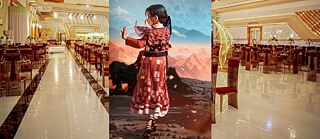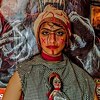نندارتون
افغانستان راتلونکی ته کتنه: محرک خیالونه

with works by Shiraz Fazli and Qeas Pirzad, Parwana Haydar and the AVAH Collective
د هنرمندانو کار یو تاریخی مګر د خوب په څیر کلتوري جمالیات په غاړه لری، چي دواړه مخکینی او شاته لید ته اجازه ورکوي. د دود او بغاوت تر مینځ په دې کړکیچ کي ، چي د یوی مرجع او ماسک په توګه کار کوي، نوی آزاد شوی حقایق د واکمنی څخه بهر رامینځته کیږی، لکه کلتوری داستانونه. په ګډه هنرمندان هڅه کوي، چي د راتلونکی لپاره یو ډله ایز لید را مینځته کړی، چي د افغان مهاجرینو له تجربو څخه تر لاسه کیږی.
Works
Shiraz Fazli: تکھ تکھ تکھ می شوم (I break apart) Traditional Afghan garments are pieced together from patterned fabrics, mirrors, beadwork, and emboridery. They may also be adorned with hanging, beaded talismans called gul-e-peran and as such offer the body both protection both physically and psychically. تکھ تکھ تکھ می شوم (I break apart) is a tapestry comprised of an assortment of found materials. Pieces of fabric, rice bags, ragdolls, paintings, used clothing, mirrors, beads, and sequins come together to form a collage that resembles traditional Afghan textile work and reflects on the hybrid nature of Afghan cultural artforms.
Qeas Pirzad: The daybreak of utopia
When the rainfall washes away the last cries of despair
And the sun rays dry the last tears of sorrow
The smiles emerge from each corner of the land
From the westernmost point of Herat to the farthest east of Badakhshan
Lighting up the dark and forgotten homes
Calling the forsaken ones to return
Because the sun is rising in our home
Parwana Haydar - Foot ache
Foot ache is a video collage of an AI generated young Afghan girl dancing on rubble, to the traditional frame drum daira, in the changing background of empty opulent Kabul wedding halls. In the glittery, kitsch, hi-tech wedding halls of Kabul, Afghanistan exists an isolated form of liberation for the lucky few who are invited to wedding ceremonies under the current Taliban regime. Women wear their finest dresses in multiple colors of chiffon and twirl to the rhythm of cassettes and classical Afghan music. Afghan futurism may exist in this temporary space of dance and joy, whilst outside on Kabul’s streets remains a dystopia for many women who are forced to wear shapeless gowns and most recently are banned from Universities.
Artists:
Shiraz Fazli is a Brooklyn-based artist and educator. Her work combines textiles with painting to create


AVAH (Afghan Visual Arts & History) is an independent and global research collective and multimedia platform. It arose due to the lack of available information and long-term initiatives on the historical and contemporary practices originating in or related to Afghanistan. By collecting art histories, contextualizing practices and creating a professional network, AVAH aims to create important resources that contribute to the understanding of the past and equip the current generation of artists and cultural workers at home and abroad.
جزئیات
Kunsthaus ACUD
بیه: تکت وړیا دی